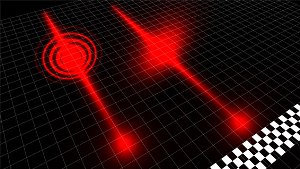Jan 27 2015
Scientists have long known that the speed of light can be slowed slightly as it travels through materials such as water or glass.

However, it has generally been thought impossible for particles of light, known as photons, to be slowed as they travel through free space, unimpeded by interactions with any materials.
In a new paper published in Science Express researchers from Heriot-Watt and the University of Glasgow describe how they have managed to slow photons in free space for the first time. They have demonstrated that applying a mask to an optical beam to give photons a spatial structure can reduce their speed.
Their experiment was configured like a race, with two photons released simultaneously across identical distances towards a defined finish line.
The team compares a beam of light, containing many photons, to a team of cyclists who share the work by taking it in turns to cycle at the front. Although the group travels along the road as a unit, the speed of individual cyclists can vary as they swap position.
The group formation can make it difficult to define a single velocity for all cyclists, and the same applies to light. A single pulse of light contains many photons, and scientists know that light pulses are characterised by a number of different velocities.
The researchers found that one photon reached the finish line as predicted, but the structured photon which had been reshaped by the mask arrived later, meaning it was travelling more slowly in free space. Over a distance of one metre, the team measured a slowing of up to 20 wavelengths, many times greater than the measurement precision.
The work demonstrates that, after passing the light beam through a mask, photons move more slowly through space. Crucially, this is very different to the slowing effect of passing light through a medium such as glass or water, where the light is only slowed during the time it is passing through the material – it returns to the speed of light after it comes out the other side. The effect of passing the light through the mask is to limit the top speed at which the photons can travel.
The work was carried out by a team from the University of Glasgow’s Optics Group, led by Professor Miles Padgett, working with theoretical physicists led by Stephen Barnett, in partnership with Professor Daniele Faccio from Heriot-Watt’s Institute of Photonics and Quantum Sciences.
Professor Faccio said, “The speed of light is a universal constant and plays a central role in our understanding of the Universe and Einstein's theory of relativity. The exciting discovery here is that this speed is the true speed of light only for plane waves, that is waves that are perfectly flat. In everyday situations however, we interact with light that is not a plane wave but has some kind of structure on it. The presence of this structure (think of the light beam emitted from a laser pointer) forces the light to actually move slower. There are lots of technicalities involved in the actual experiments used to measure this slow-down, but the result is widely applicable. A very appropriate discovery for the 2015 international year of light".
Professor Padgett added, “It might seem surprising that light can be made to travel more slowly like this, but the effect has a solid theoretical foundation and we’re confident that our observations are correct.
“The results give us a new way to think about the properties of light and we’re keen to continue exploring the potential of this discovery in future applications. We expect that the effect will be applicable to any wave theory, so a similar slowing could well be created in sound waves, for example.”
The team’s paper, titled ‘Spatially Structured Photons that Travel in Free Space Slower than the Speed of Light’, is published in Science Express, which provides electronic publication of selected papers in advance of print in the journal Science.